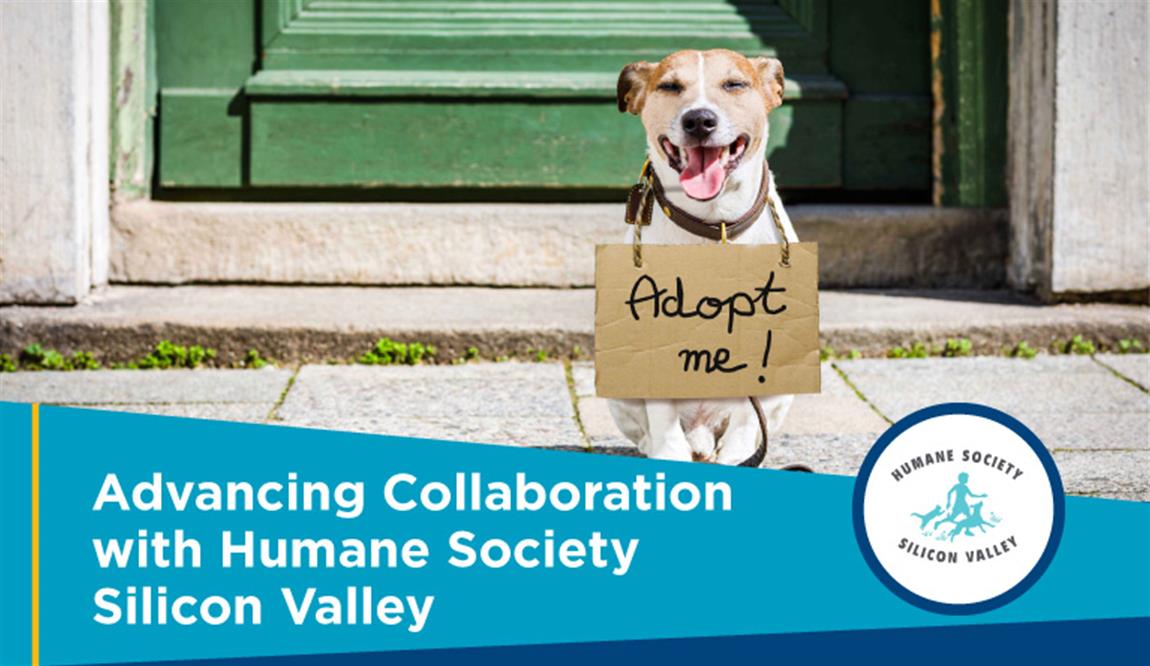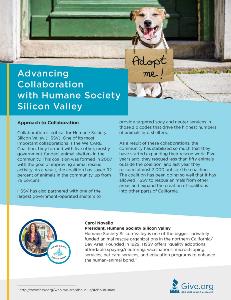
Humane Society Silicon Valley is one of the biggest privately funded animal rescue organizations in the northern California/Bay Area. Founded in 1929, HSSV offers “quality adoptions, affordable spaying/neutering, vaccinations, microchipping services, pet care services, and education programs to enhance the human-animal bond.”1
Featured Guest
Carol Novello, President
Humane Society
Silicon Valley
Approach to Collaboration
Collaboration is critical for Humane Society Silicon Valley (HSSV). One of its most important collaborations is the We CARE Coalition, they formed with five other, mostly government-funded, animal shelters in the community. This coalition was formed in 2007 with the goal of improving animal rescue activity. As a result, the coalition has saved 92 percent of animals in the community, up from 75 percent.
HSSV has also partnered with one of the largest government-operated shelters to provide targeted spay and neuter services in those zip codes that drive the highest numbers of animals into shelters.
As a result of these collaborations, the community has stabilized so much that they have started expanding their rescue work. Five years ago, they rescued less than fifty animals outside the coalition, and last year they rescued almost 3,000 outside the coalition. The coalition has been doing so well that it has allowed HSSV to rescue animals from other areas and expand the creation of coalitions into other parts of California.
Application of the 9 Considerations for Collaboration
Build Trust
To effectively accomplish this work, the coalition requires trust more than anything else. Having common values and goals are also very important to building trust; moreover, it is important to be explicitly clear on expectations and to follow through on promises. Sometimes, this means saying no to some things you are unable to do.
Have a Vision
The coalition started with a grant to save all healthy animals in their community. When the coalition reached that milestone, that vision evolved to include saving not only all healthy animals but also those animals needing rehabilitation.
Seek to Assure the Success of Collaborators
Most coalition members do not compete for funding, but they do compete for animal adopters. As such, the coalition strives for more overall adoptions, rather than more adoptions for a specific organization. This way it ensures the success for all members. It’s important to think about your community as an ecosystem where the success of your collaborators is a win for everyone.
Take Stock
During its annual strategic planning process, HSSV takes stock of the resources it can bring to the community. For example, HSSV partnered with the University of California, Davis to meet the guidelines of the Association of Shelter Veterinarians (ASV) and became the first model shelter.
HSSV brings its knowledge and expertise in shelter medicine to help other shelters meet ASV guidelines and to its collaborations, improving the global ecosystem of shelters. HSSV also lends their expertise on the integration of animal welfare with human services.
For example, pets can help homeless people transition more smoothly back into stable situations. As such, HSSV partners with human service organizations that integrate animals into their programs.
Start Small
HSSV does this internally. It believes it’s best to start small with a proof of concept. For example, HSSV found that 30 percent of the animals it receives came from five economically, challenged neighborhoods. So, it started doing free surgeries in its medical clinic for residents in those zip codes. After determining there was demand from residents for these services, it then expanded into mobile clinics in these neighborhoods and partnered with local businesses to park the clinics in their parking lots. This way, it lowered the risk on this project by not rolling everything out at once.
Fail Fast, and Build Rigorous Feedback Loops
HSSV opened a new adoption center in a pet store that provided retail space for that purpose, but the retailer did not provide much marketing support. The partnership did not succeed because HSSV’s goals did not align with the goals of the pet store partner. So, it decided to end the partnership and focus on adoption centers that HSSV already had.
Take a Portfolio Approach
HSSV works in three main areas: rescue work, shelter medicine, and human services, with each at different stages of development. Each of these areas requires different approaches and involves different kinds of collaborations.
Consider Non-traditional Partners
An example of a non-traditional partner is HSSV’s program to house animals of domestic violence victims. Having animals is a common reason why people stay in violent environments because they do not have anywhere else to leave the animal. Thus, there is a lot of work to be done together with social agencies.
Keep Your Donors Apprised of Your Collaborations
HSSV focuses on what it calls the “culture of philanthropy” and believes that raising money is not only the job of the development team. Everyone in the organization should engage with the community, and in doing so, that helps create a climate that makes it easier to raise funds for the organization. HSSV has a whole program built around showing its mission impact to donors. It does a lot of stewardship work with donors like events and activities to bring them closer to the mission.
Future Collaborations
For future collaborations, HSSV would like to partner with organizations to help with tech solutions for data sharing and other needs..
1 http://www.hssv.org/who-we-are/about-us/#aboutusnav



